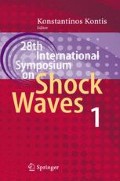Introduction
Accurate analysis of experimental data from hypersonic impulse facilities is difficult due to the limited amount of free-stream flow property data that can be measured at the nozzle exit. Reflected shock tunnels (RSTs) are particularly difficult due to short test periods and high total pressures. To over come the lack of knowledge at nozzle exit in RSTs, experimenters typically calculate the quasi-steady gas properties at nozzle exit based on assumption that the test gas is processed, in stages, by idealized waves that are essentially decoupled. Such a simplified calculation uses shock tube initial fill conditions, experimental incident shock speed, stagnation pressure and Pitot pressure as inputs.
Access this chapter
Tax calculation will be finalised at checkout
Purchases are for personal use only
Preview
Unable to display preview. Download preview PDF.
References
Chue, R.S., Eitelberg, G.: Studies of transient flows in high enthalpy shock tunnels. Experiments in Fluids 25, 474–486 (1998)
Goozee, R.J., Jacobs, P.A., Buttsworth, D.A.: Simulation of a complete reflected shock tunnel showing a vortex mechanism for flow contamination. Shock Waves 15(3-4), 165–176 (2006)
Dann, A.G.: Shock wave/boundary layer interactions in hypersonic ducted flows. PhD Thesis, The University of Queensland, Australia (2009)
Jacobs, P.A.: Shock tube modeling with L1d. Report No. 13/98, Department of Mechanical Engineering, The University of Queensland, Australia (1998)
Jacobs, P.A.: mb_cns A computer program for the simulation of transient compressible flows. Report No. 10/96, Department of Mechanical Engineering, The University of Queensland, Australia (1996)
Author information
Authors and Affiliations
Editor information
Editors and Affiliations
Rights and permissions
Copyright information
© 2012 Springer-Verlag Berlin Heidelberg
About this paper
Cite this paper
McGilvray, M., Dann, A.G., Jacobs, P.A. (2012). Modeling the Complete Operation of a Free-Piston Shock Tunnel for a Low Enthalpy Condition. In: Kontis, K. (eds) 28th International Symposium on Shock Waves. Springer, Berlin, Heidelberg. https://doi.org/10.1007/978-3-642-25688-2_107
Download citation
DOI: https://doi.org/10.1007/978-3-642-25688-2_107
Publisher Name: Springer, Berlin, Heidelberg
Print ISBN: 978-3-642-25687-5
Online ISBN: 978-3-642-25688-2
eBook Packages: EngineeringEngineering (R0)

